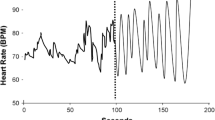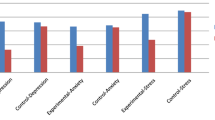Abstract
This study examined whether group progressive relaxation training was as effective as individual EMG biofeedback training in facilitating the academic achievement and self-control of 45 hyperactive elementary school children. Academic achievement was assessed with the Gates-MacGinities Reading Tests, and self-control was measured with the Nowicki-Strickland and the Teacher Rating scales. Eight sessions were scheduled at weekly intervals. Progressive relaxation was conducted in groups of seven or eight and was induced with a commercial audiocassette program. EMG training augmented frontalis biofeedback with those taped exercises. A placebo group listened to taped children's stories. Multivariate analysis of variance indicated no significant differences among the three contrast groups when all dependent variables were considered together. However, univariate F values and discriminant analysis disclosed locus of control to be significantly more internal for the progressive relaxation condition. Also, differences between the two relaxation and the placebo groups, though not statistically significant, were all in the expected direction. While the relative efficacy of group progressive relaxation could not be established conclusively, the data appeared sufficiently positive to warrant further investigation of this cost-effective prospective intervention.
Similar content being viewed by others
References
Ackerman, D. T., Dykman, R. A., & Peters, J. E. (1977). Teenage status of hyperactive and non-hyperactive learning disabled boys.American Journal of Orthopsychiatry, 47 577–596.
Ayllon, T., Layman, D., & Kandel, H. (1975). A behavioral-education alternative to drug control of hyperactive children.Journal of Applied Behavior Analysis, 8 137–147.
Ballard, K. D., & Glynn, T. (1975). Behavior self-management in story writing with elementary school children.Journal of Applied Behavior Analysis, 8 387–398.
Bateman, B. (1965). An educator's view of the diagnostic approach to learning disorders. In J. Helmuth (Ed.),Learning disorders (Vol. 1). Seattle: Special Child Publications.
Bhatara, V., Arnold, L. E., Lorance, T., & Gupta, D. (1979). Muscle relaxation therapy in hyperkinesis: Is it effective?Journal of Learning Disabilities, 12 182–186.
Braud, L. W. (1978). The effects of frontalis EMG biofeedback and progressive relaxation upon hyperactivity and its behavioral concomitants.Biofeedback and Self-Regulation, 3 69–89.
Braud, L. W., Lupin, M. N., & Braud, W. G. (1975). The use of electromyographic biofeedback in the control of hyperactivity.Journal of Learning Disabilities, 8 21–26.
Carlson, J. G. (1977). Locus of control and frontal electromyographic response training.Biofeedback and Self-Regulation, 2 259–271.
Carter, J., & Synolds, D. (1974). Effects of relaxation training upon handwriting quality.Journal of Learning Disabilities, 7 236–238.
Cobb, D. E., & Evans, J. R. (1981). The use of biofeedback techniques with school-aged children exhibiting behavioral and/or learning problems.Journal of Abnormal Child Psychology, 9 251–156.
Denkowski, K. M., Denkowski, G. C., & Omizo, M. M. (1983). The effects of EMG-assisted relaxation training on the academic performance, locus of control, and self-esteem of hyperactive boys.Biofeedback and Self-Regulation, 8 363–375.
Denkowski, K. M., Denkowski, G. C., & Omizo, M. M. (1984). Predictors of success in the EMG biofeedback training of hyperactive male children.Biofeedback and Self-Regulation, 9 253–264.
Disney Productions. (1968).Children's stories. Hollywood: Producer (Audiocassette).
Douglas, V. I. (1974). Sustained attention and impulse control: Implications for the handicapped child. J. A. Swets & L. L. Elliot (Eds.),Psychology and the handicapped child. Washington, D.C.: Office of Education.
Dunn, F. M., & Howell, R. J. (1982). Relaxation training and its relationship to hyperactivity in boys.Journal of Clinical Psychology, 38 92–100.
Flemings, D. G. (1979). A study of electromyographic biofeedback as a method to teach hyperactive children how to relax within a public school setting (Doctoral dissertation, University of Northern Colorado, 1978).Dissertation Abtracts International, 39, 6693A.
Gates, A. I., & MacGinitie, W. H. (1965).Gates-MacGinitie reading tests. New York: Teachers College Press.
Gittleman, R., Abikoff, H., Pollack, D. F., Klein, S., Katz, S., & Mattes, J. (1980). A controlled trial of behavior therapy and methylphenidate for hyperactive children. In C. K. Whalen & B. Henker (Eds.),Hyperactive children. New York: Academic Press.
Haight, M., Jampolsky, G., & Irvine, A. (1978).The response of hyperkinesis to EMG biofeedback. Paper presented at the meeting of the Biofeedback Society of America, Albuquerque.
Hampstead, W. J. (1979). The effects of EMG-assisted relaxation training with hyperkinetic children.Biofeedback and Self-Regulation, 4 113–125.
Hughes, H., Henry, D., & Hughes, A. (1980). The effect of frontalis EMG biofeedback training on the behavior of children with activity-level problems.Biofeedback and Self-Regulation, 5 207–219.
Hieronymous, D., & Lindquist, R. (1964). Manual for administrators, supervisors, and counselors.Iowa Test of Basic Skills. Boston: Houghton Mifflin.
Lefcourt, H. M. (1976).Locus of control. New York: John Wiley & Sons.
Lupin, M. (1977).Peace, harmony, awareness. San Antonio: Learning Concepts (Audiocassette).
Lupin, M., Braud, L. W., Braud, W., & Duer, W. F. (1976). Children, parents and relaxation tapes.Academic Therapy, 12 105–113.
Meichenbaum, D. (1976). Cognitive factors in biofeedback therapy.Biofeedback and Self-Regulation, 2 201–216.
Nowicki, S., & Strickland, B. (1973). A locus of control scale for children.Journal of Clinical and Consulting Psychology, 40 148–154.
Omizo, M. M. (1980a). The effects of biofeedback-induced relaxation training on hyperactive adolescent boys.Journal of Psychology, 105 131–138.
Omizo, M. M. (1980b). The effects of relaxation training and biofeedback on dimensions of self-control among hyperactive male children.Educational Research Quarterly, 5 22–30.
Omizo, M. M., & Williams, R. E. (1982). Biofeedback-induced relaxation training as an alternative for the elementary school learning-disabled child.Biofeedback and Self-Regulation, 7 139–148.
Patmon, R., & Murphy, P. J. (1978).Differential treatment efficacy of EEG and EMG biofeedback for hyperactive adolescents. Paper presented at the meeting of the Biofeedback Society of America, Albuquerque.
Rivera, E., & Omizo, M. M. (1980). The effects of relaxation training and biofeedback on attention to task and impulsivity among male hyperactive children.Exceptional Child, 27 41–51.
Rotter, J. B. (1966). Generalized expectancies for internal versus external control of reinforcement.Psychological Monographs, 80 (1, Whole No. 609).
Safer, D., Allen, R., & Barr, E. (1972). Depression of growth in hyperactive children on stimulant drugs.New England Journal of Medicine, 287 217–220.
Sandoval, J. (1977). The measurement of the hyperactive syndrome in children.Review of Educational Research, 47 293–318.
Sandoval, J., Lambert, N. M., & Sassone, D. (1980). The identification and labelling of hyperactivity in children: An interactional model. In C. K. Whalen & B. Henker (Eds.),Hyperactive children. New York: Academic Press.
Schandler, S. L., & Grings, W. W. (1976). An examination of methods for producing relaxation during short-term laboratory sessions.Behavior Research and Therapy, 14 419–426.
Stoyva, J. M., & Budzinski, T. H. (1974). Cultivated low arousal: An anti-stress response? In L. V. DiCara (Ed.),Limbic and autonomic nervous system research. New York: Plenum.
Varni, J. W. (1976).A cognitive-behavior self-regulation approach to the treatment of the hyperactive child. Unpublished doctoral dissertation, University of California, Los Angeles.
Venables, P. H., & Martin, I. (Eds.). (1967).A survey of psychophysiological methods. Amsterdam: North Holland, 1967.
Whalen, C. K., & Henker, B. (Eds.) (1980).Hyperactive children. New York: Academic Press.
Wolpe, J., & Lazarus, A. (1966).Behavior therapy techniques. Oxford: Pergamon.
Author information
Authors and Affiliations
Additional information
The opinions expressed by the authors are not necessarily those of their respective institutions.
Rights and permissions
About this article
Cite this article
Denkowski, K.M., Denkowski, G.C. Is group progressive relaxation training as effective with hyperactive children as individual EMG biofeedback treatment?. Biofeedback and Self-Regulation 9, 353–364 (1984). https://doi.org/10.1007/BF00998978
Issue Date:
DOI: https://doi.org/10.1007/BF00998978




